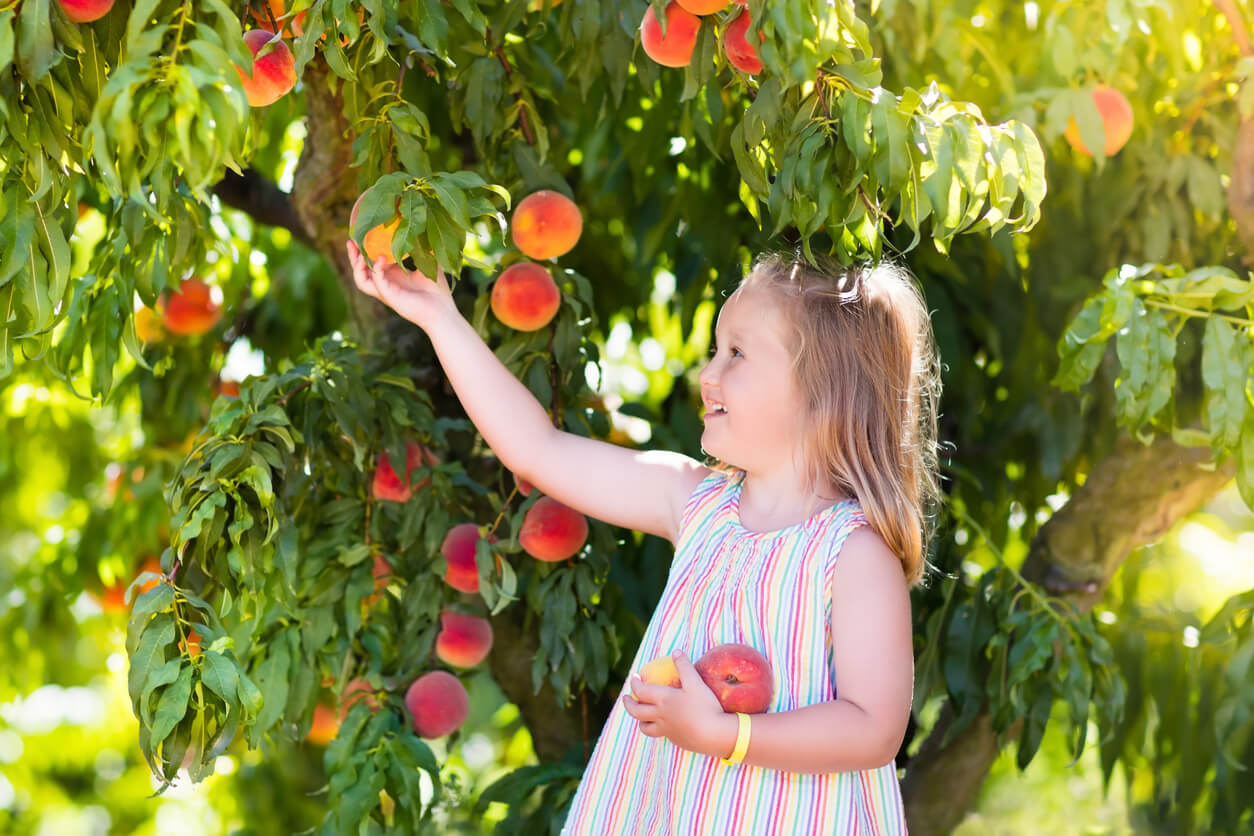Whether spring or fall, both are great times to start your backyard orchard! If you’ve been following along for some time, you know that when we bought our house, it had the most beautiful flower gardens, but I had a hard time loving them. In fact, I sort of hated them, because I didn’t know these plants. Does that make sense? They were planted by someone who clearly loved them, but my heart just wasn’t feeling it. Over the years I have slowly transformed much of the land from flowers to food, starting with my largest plot of veggies, front and center, with berry bushes along the edges, and a solo apple tree—don’t worry, my neighbor has eight more for a pollination assist.
I’ve gotten to the next stage, where I’m making the mighty attempt to make my yard more orchard-like, but I’m starting small. A few things I decided I wanted out of this mini starter backyard orchard:
- Season-long blooming and fruits from spring through fall—just not all at the same time
- Self-pollinating fruits so I didn’t need more than one (I made an exception for pawpaws)
- Disease-resistant
- Cold-hardy (I’m in New England)
Some folks may also consider non-invasive an important marker, weeding out mulberries, blackberries, and raspberries.
My everbearing backyard orchard
Don’t worry, this isn’t all about my little garden, but I’m dying to share my backyard orchard plan. I’m starting with six trees, and I made a self-pollinating exception for pawpaws because I just want to grow them so badly and I learned I have neighbors who grow them! This post isn’t about my little orchard per se, but I did want to share with you what I got, in case you live in a similar USDA planting zone (I’m in 5b). Keep in mind that these months apply to four-season climates, and are much earlier in warmer climates.
- For June fruits, I chose a Benton sweet cherry tree, because it’s a rare self-pollinating sweet cherry tree similar to Bing.
- For July fruits, I chose the Santa Rosa plum tree, which produces sweet, slightly tart plums in less years than most plum trees and is self-pollinating.
- For August fruits, I chose the Glohaven peach tree, which is very sweet, self-pollinating, disease-resistant, and perfect for eating fresh or for canning.
- For September, I chose the Spitzenburg apple tree, because chefs love it, though I’m two years into its growth and it does seem prone to cedar rust, and I haven’t found the culprit yet.
- For October, I chose the Sunflower pawpaw tree, which produces fruit with a sweet banana-custard flavor and creamy flesh, and that are disease-resistant.
If you have tips and tricks, please let me know!
How to plant YOUR everbearing backyard orchard
Now let’s get to the fruit of our post, which is the order in which fruit plants and trees make fruit in the season so that you can plant an everbearing backyard orchard. The months will always differ, but the order mostly does not, which is why I’ve kept this list to the order of harvest. Before choosing plants, always make sure that they will grow in your zone, and that you actually want to eat them. For example, there are cold-hardy pomegranate trees, but I didn’t plant them because I have no idea what I’d do with a whole tree of pomegranates!
Without further ado, if you want an everbearing backyard fruit orchard, you can pick fruits from these spring, summer, fall, and winter categories so that you always have an abundance of fruit (and not all at the same time—unless you want that!)
A few things to note, because this isn’t an exact science:
- Before purchasing, check your varietal. Some may be early-season varietals that you can harvest earlier.
- If a plant is everbearing that means it will produce fruit all season long.
- Make sure if the plant isn’t self-pollinating that you get at least two—or more if suggested.
- Disease-resistant varieties will make your life easier. They are also likely genetically modified, but so are most things we eat and grow to some extent.
- Consider pairing your trees with their fruit tree companion plants.
Early spring fruit trees and plants
Late spring fruit trees and plants
Early summer fruit trees and plants
Late summer fruit trees and plants
Early fall fruit trees and plants
Late fall fruit trees and plants
Winter fruit trees
Consider this a non-exact list, because seasons are different, and so are the harvesting times of different varietals. But in general, you can use this list as a basic order of harvesting if you want to plant a backyard orchard that is essentially everbearing all season.
If you have planted a backyard orchard, let me know if you’ve learned anything along the way that we could all benefit from!
[affiliate_note]
Explore the easiest fruit to grow at home—indoors or out! Read our FREEBIE 15 Easiest Fruits to Grow at Home, right now!

2 replies on “Planning a Backyard Orchard You Can Harvest Year-Round”
Our 25-year old persimmon trees just passed away over a 3 year period. Don’t know why, we had 2 Fuyu Persimmons (pick and eat while firm) and 2 Hachiya (wait until soft to eat, or dried they make great dried fruits). Sure will replace them, they are great in salads or savory dishes!
I agree that the Esopus Spitzenburg is a very fine apple – it was reputedly Thomas Jefferson’s favourite apple. But the significant thing in the present context is that it is reportedly prone to just about every possible disease and pest, (Cummins Nursery and others). There are other cultivars a lot easier to grow.